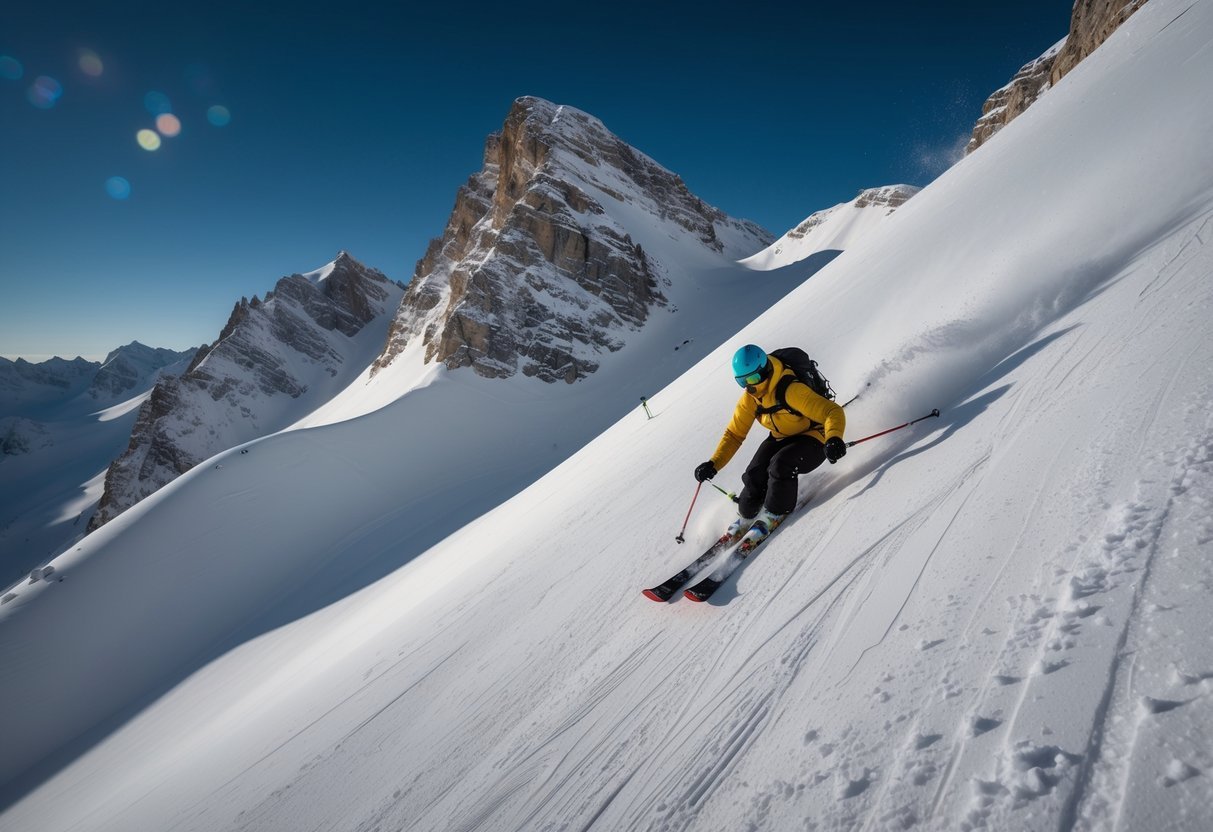Extreme skiing pushes the boundaries of what’s possible on the slopes.
It takes you beyond groomed runs and ski resorts into wild, untamed terrain where the risks are high but the rewards are unmatched.
If you’re ready to take your skiing to the next level, it’s crucial to be prepared. Knowing how to survive in extreme conditions can make the difference between an epic adventure and a dangerous situation. This guide will equip you with essential knowledge to tackle the most challenging ski environments safely and confidently.
1) Avalanche Awareness Course
Extreme skiing comes with serious risks, and avalanches top the list.
Taking an avalanche awareness course is crucial for your safety in the backcountry.
These courses teach you how to spot potential avalanche dangers and make smart decisions in risky terrain.
You’ll learn about snow conditions, weather patterns, and terrain features that contribute to avalanche risk.
Instructors will show you how to use essential safety gear like beacons, probes, and shovels.
You’ll practice rescue techniques in simulated avalanche scenarios.
Communication and group dynamics are key components of these courses.
You’ll discover how to work as a team and avoid common decision-making pitfalls that can lead to dangerous situations.
Many ski areas offer introductory avalanche safety courses.
For a more comprehensive education, look into Level 1 Avalanche courses certified by professional organizations.
Remember, knowledge is power when it comes to avalanche safety.
The skills you learn could save your life or someone else’s on the mountain.
2) Layering Techniques
Proper layering is crucial for staying warm and dry during extreme skiing adventures.
You’ll want to start with a thin, moisture-wicking base layer that hugs your body.
This helps move sweat away from your skin.
Next, add an insulating mid-layer for warmth. A fleece or thicker layer works well, especially in colder conditions.
You can adjust this layer based on the temperature and your activity level.
Top it off with a waterproof and breathable outer layer.
This protects you from wind and snow while allowing moisture to escape.
Look for jackets and pants with good ventilation options.
Don’t forget about your extremities.
Wear warm, moisture-wicking socks and consider layering your gloves too.
A thin liner under your ski gloves can provide extra warmth without sacrificing dexterity.
Remember, you can always remove layers if you get too warm.
It’s better to have options than to be caught unprepared in extreme conditions. Experiment with different combinations to find what works best for your body and the conditions you’ll face.
3) Emergency Beacon Essentials
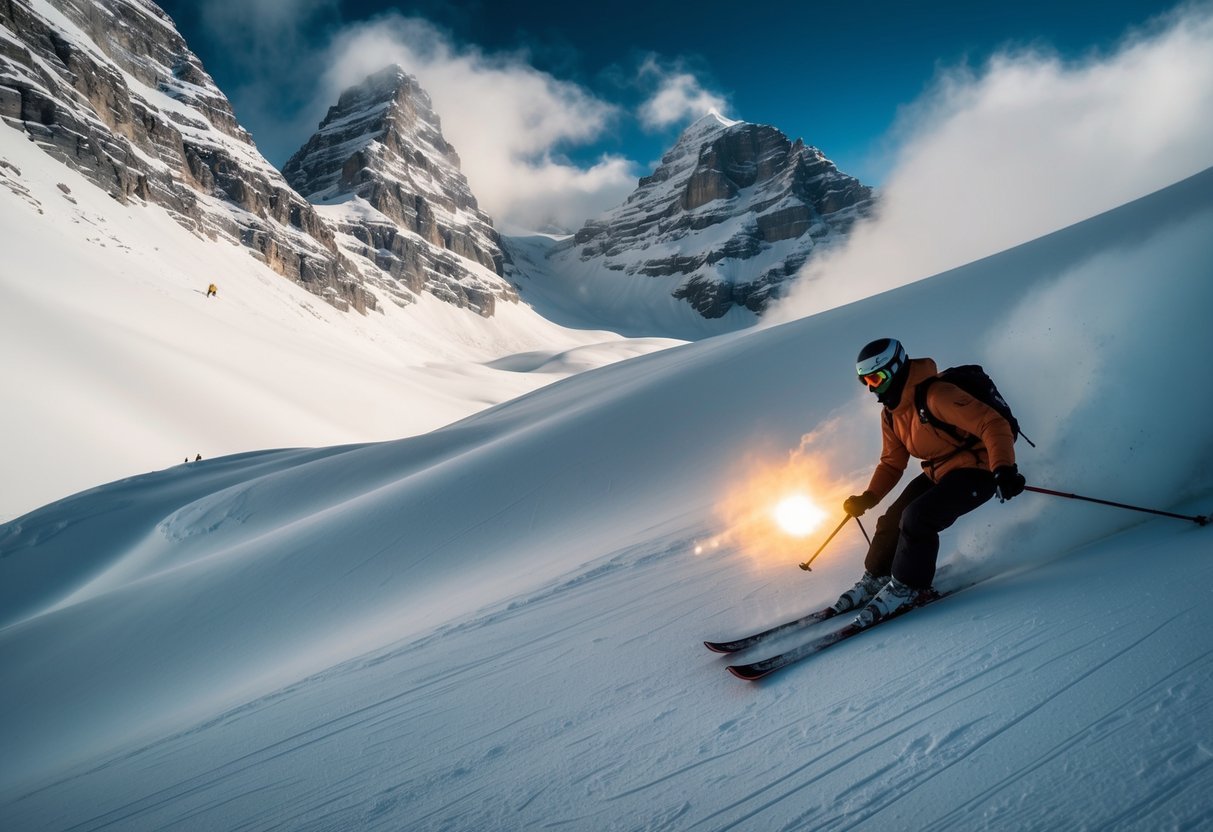
When you’re out in the backcountry, an avalanche transceiver is a must-have piece of gear.
Don’t confuse it with a personal locator beacon (PLB) – they’re different tools.
Your transceiver, also called a beacon, helps rescuers find you if you’re buried in snow.
Make sure you know how to use it before hitting the slopes.
Practice with your ski buddies regularly.
Keep your beacon in top shape by storing it properly when the season’s over.
Clean and dry storage is key.
Check the batteries before each trip.
Some modern beacons come with extra features.
The Mammut Barryvox S has a big screen and fancy icons.
But remember, the basics are what count in an emergency.
Your beacon is just one part of your avalanche safety kit.
Don’t forget your probe and shovel.
These three items work together to keep you and your crew safe in the backcountry.
4) Backcountry Navigation Skills
When you’re out in the wild, knowing how to navigate is crucial.
You can’t rely on your phone’s GPS in the backcountry, so it’s time to brush up on your map and compass skills.
Before you head out, plan your route carefully.
Identify landmarks, potential hazards, and safe zones.
This prep work will save you time and energy on the slopes.
Pack a topographic map and compass, and know how to use them.
Practice taking bearings and triangulating your position.
These skills could be lifesavers if you get disoriented in whiteout conditions.
Consider carrying a satellite communication device.
It can be a game-changer for calling for help if things go south.
Remember, technology can fail, so don’t rely on it exclusively.
Familiarize yourself with the terrain before you go.
Study satellite imagery and recent trip reports.
This knowledge will help you make better decisions on the fly.
Learn to read snow conditions and weather patterns.
They can affect your route and safety.
Being able to spot potential avalanche terrain is a must-have skill in the backcountry.
5) Survival Tent for Emergencies
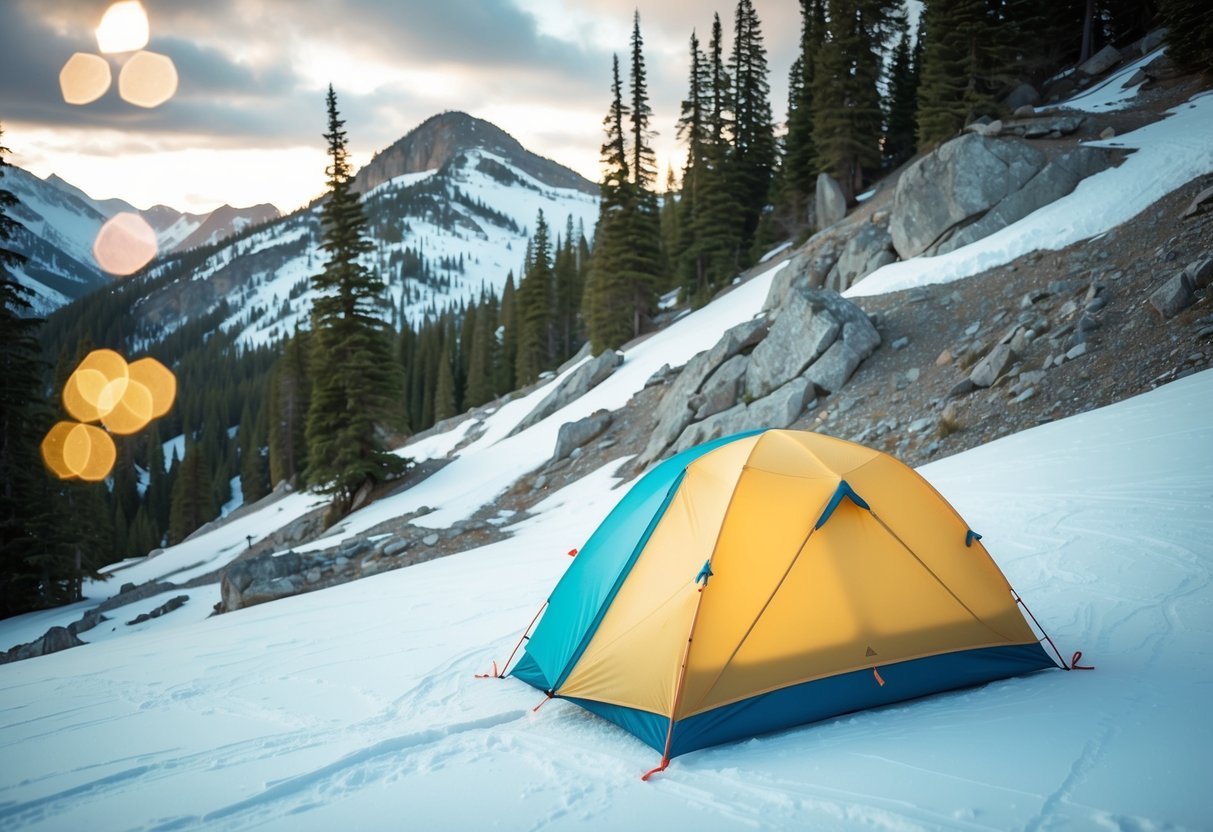
When you’re out extreme skiing, having a survival tent can be a real lifesaver.
These compact shelters are designed to protect you from harsh weather conditions if you get stuck on the mountain.
Look for a tent that’s lightweight and easy to carry in your backpack.
You don’t want it weighing you down during your ski runs.
Choose a tent that can withstand strong winds and heavy snow.
Some survival tents are specifically built to handle extreme weather, which is exactly what you need for skiing emergencies.
Make sure your tent is quick to set up.
In an emergency situation, you’ll want to get shelter fast without fumbling with complicated poles and stakes.
Consider a tent with reflective material.
This can help rescue teams spot you more easily if you’re stranded.
Practice setting up your tent before you hit the slopes.
You’ll be glad you did if you ever need to use it in a pinch.
6) First Aid Kit Basics
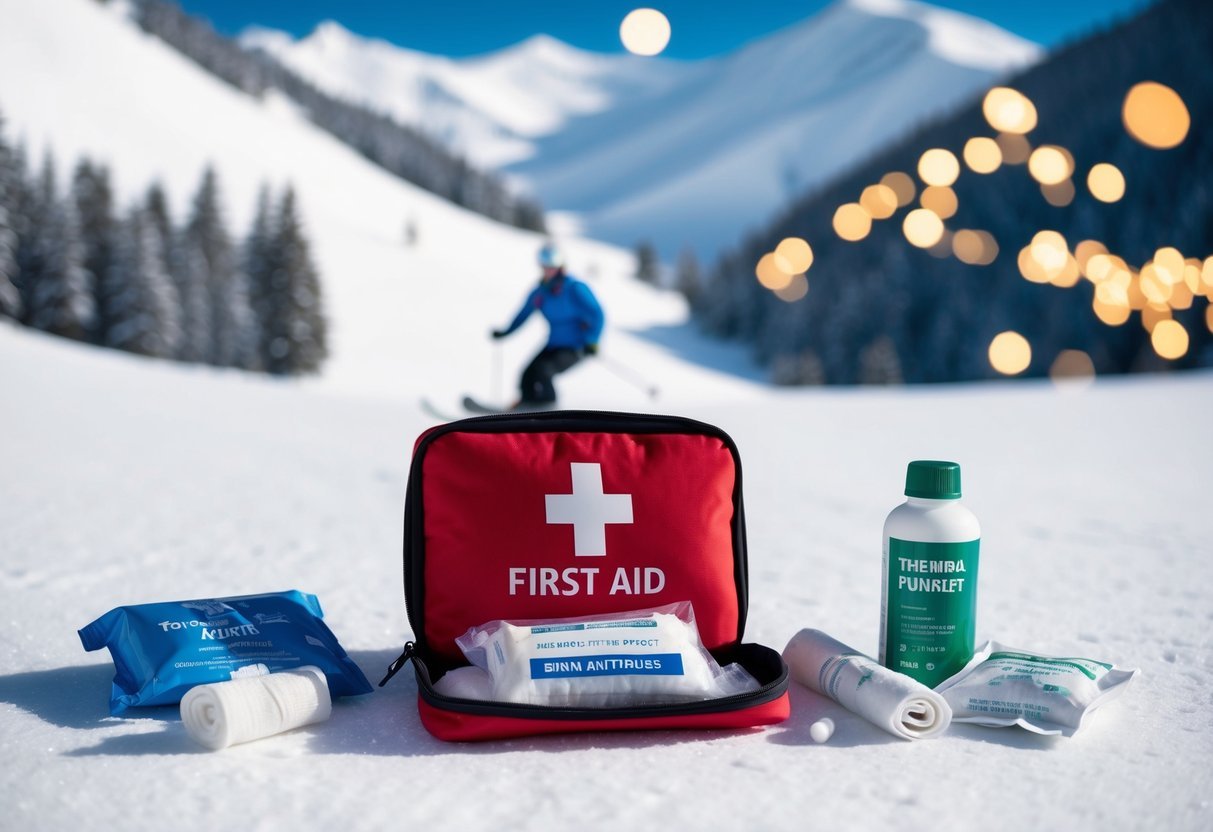
When you’re out extreme skiing, a solid first aid kit is a must-have.
You never know when you might need it, so it’s better to be prepared.
Start with the essentials: bandages, gauze, and adhesive tape.
These will help you patch up minor cuts and scrapes on the go.
Don’t forget pain relievers and anti-inflammatory meds.
They can be a lifesaver when you’re dealing with aches and pains from a long day on the slopes.
Hypothermia is a real risk, so pack an emergency blanket.
It’s lightweight and can keep you warm in a pinch.
Throw in some antiseptic wipes and antibiotic ointment.
These will help prevent infections if you get a gnarly cut.
Consider adding a few safety pins and a small pair of scissors.
They’re handy for adjusting bandages or cutting tape.
Remember, knowing how to use your kit is just as important as having one.
Take a first aid course to brush up on your skills before hitting the backcountry.
7) Proper Nutrition and Hydration
When you’re tackling extreme skiing, fueling your body right is crucial. Complex carbohydrates like whole grains, fruits, and vegetables are your best friends on the slopes.
They’ll give you the sustained energy you need to power through challenging runs.
Don’t forget about protein.
It’s key for muscle recovery after a long day of shredding.
Aim for a mix of lean meats, fish, or plant-based options like lentils and chickpeas.
Staying hydrated is just as important as eating right. Drink plenty of water throughout the day to avoid dehydration, which can worsen altitude sickness and affect your performance.
Pack some easy-to-eat snacks in your jacket pockets.
Energy bars, trail mix, or dried fruit can give you a quick boost when you need it most.
After skiing, refuel with a meal that combines proteins and carbs.
This helps replenish your energy stores and repair those hard-working muscles.
A turkey sandwich on whole grain bread or a protein-packed smoothie are great options.
8) Dealing with Frostbite
When you’re out shredding the gnar in frigid temps, frostbite is a real concern.
It’s no joke – frostbite can cause serious damage to your skin and tissues.
Cover up exposed skin to protect yourself.
Your ears, nose, and cheeks are particularly vulnerable, so don’t forget a good balaclava or face mask.
Layer up properly.
Moisture-wicking base layers, insulating mid-layers, and a windproof outer shell are your best defense against the biting cold.
Keep an eye on your extremities.
Your fingers and toes are often the first to feel the chill.
High-quality, waterproof gloves and boots are essential gear.
If your skin feels numb, waxy, or turns white or grayish-yellow, it’s time to get inside and warm up.
Don’t ski when it’s too cold.
Temperatures below 5°F (-15°C) significantly increase your risk of frostbite.
If you suspect frostbite, slowly warm the affected area.
Never rub frostbitten skin – it can cause more damage.
Remember, prevention is key.
Stay aware of the conditions and your body’s signals to keep your extreme skiing adventures frostbite-free.
Understanding Extreme Skiing
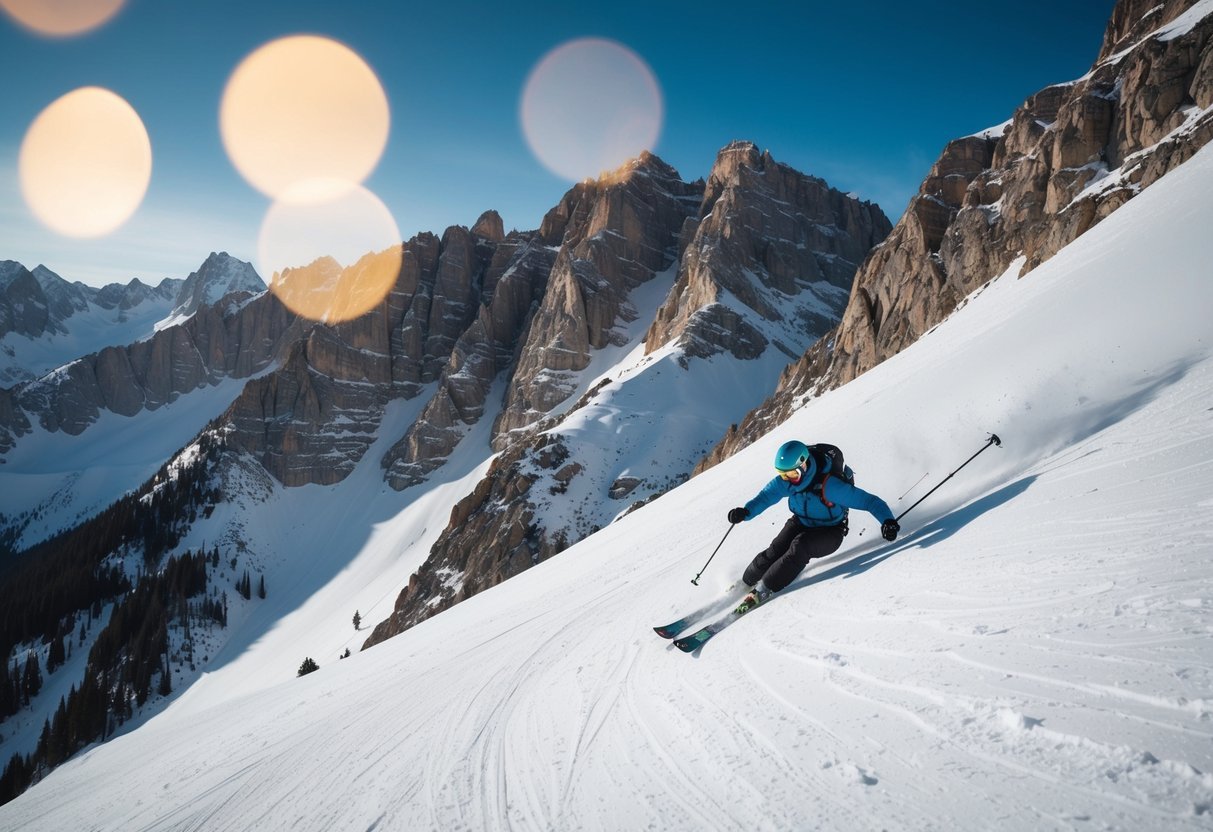
Extreme skiing pushes the boundaries of traditional downhill skiing.
It involves tackling challenging terrain and conditions that require advanced skills and a healthy dose of courage.
What Defines Extreme Skiing
Extreme skiing takes place on steep slopes, typically 45 to 60+ degrees.
You’ll find yourself navigating through narrow chutes, jumping off cliffs, and carving turns on untouched powder.
These thrilling challenges require not only advanced skiing skills but also a deep understanding of snow conditions and safety measures.
If you’re seeking adventure and adrenaline, there are numerous extreme skiing destinations to explore that offer breathtaking landscapes and exhilarating terrain.
From the rugged mountains of Alaska to the alpine slopes of the French Alps, each location presents unique challenges and stunning scenery that will captivate any extreme skiing enthusiast.
This style of skiing often involves:
- Backcountry terrain
- High altitudes
- Natural obstacles like rocks and trees
- Avalanche-prone areas
To excel at extreme skiing, you need exceptional control, balance, and quick decision-making skills.
It’s not just about speed – it’s about conquering the most challenging routes nature has to offer.
Differences Between Recreational and Extreme Skiing
Recreational skiing usually takes place on groomed slopes within ski resorts.
Extreme skiing, on the other hand, ventures into uncontrolled environments.
Key differences include:
- Terrain: Groomed vs. natural, unpredictable slopes
- Risk level: Low to moderate vs. high
- Equipment: Standard vs. specialized gear
- Skills required: Basic to intermediate vs. advanced to expert
While recreational skiing focuses on enjoyment and improvement, extreme skiing is about pushing your limits and seeking thrills.
It demands a higher level of physical fitness, mental preparation, and avalanche safety knowledge.
Safety Precautions
Taking the right safety measures can mean the difference between an epic adventure and a disaster.
Proper preparation and gear are crucial when tackling extreme skiing conditions.
Avalanche Awareness
Knowing how to spot avalanche risks is key.
Before hitting the slopes, check the local avalanche forecast and learn to recognize dangerous terrain.
Pay attention to recent weather patterns, as rapid temperature changes or heavy snowfall can increase the risk.
Learn to use avalanche safety gear like beacons, probes, and shovels.
Practice with them regularly so you’re prepared if the worst happens.
Always ski with a buddy and keep an eye on each other.
If you’re in unfamiliar territory, consider hiring a guide who knows the area well.
Essential Gear for Extreme Conditions
Your gear can make or break your extreme skiing experience.
Start with a high-quality, insulated jacket and pants designed for harsh weather.
Look for waterproof and breathable materials to keep you dry and comfortable.
Invest in a good helmet and goggles to protect your head and eyes.
For extra gnarly conditions, consider a full-face helmet.
Don’t skimp on your boots and bindings.
Make sure they’re in top condition and properly adjusted for your skill level and the terrain.
Pack emergency supplies like a first aid kit, emergency blanket, and extra food and water.
A satellite communicator can be a lifesaver if you’re skiing in remote areas without cell service.
Frequently Asked Questions
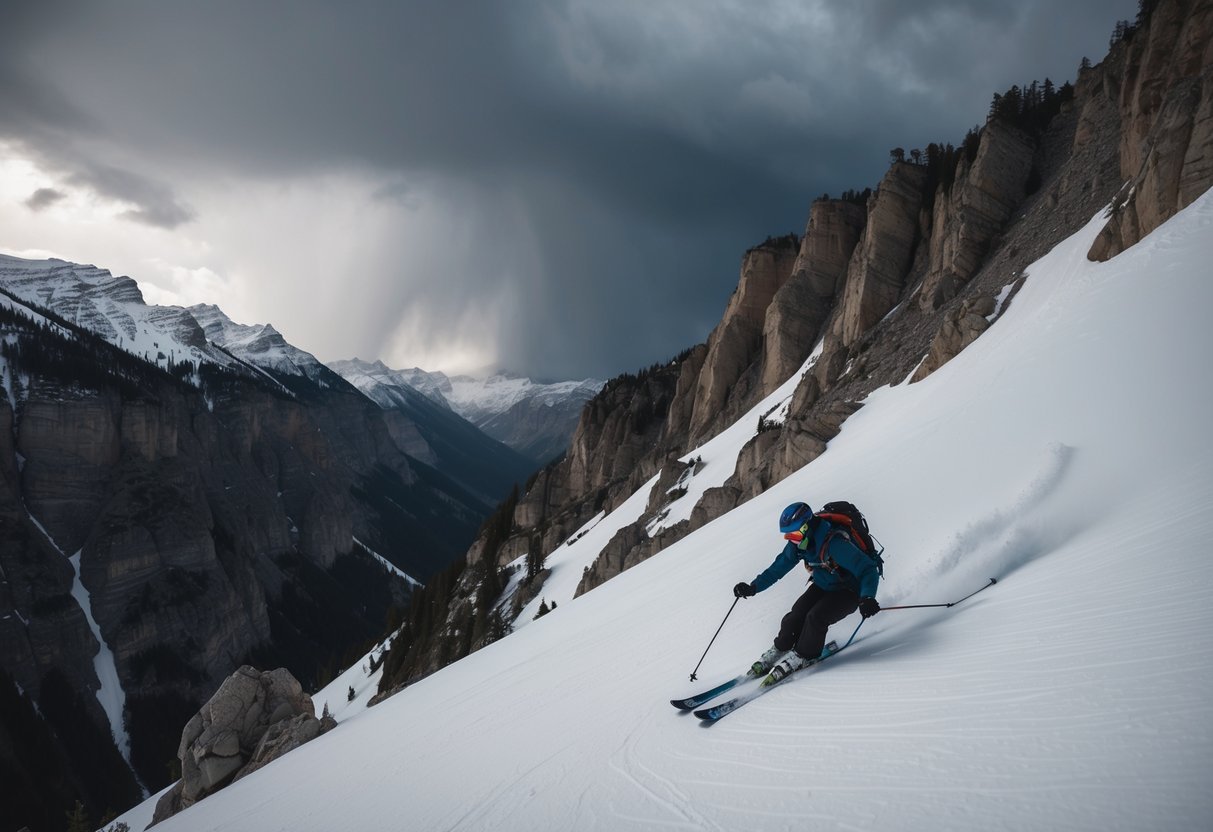
Extreme skiing requires specialized gear, thorough preparation, and a keen focus on safety.
Choosing the right location and understanding the risks are crucial for a successful adventure.
What gear do I need for extreme skiing?
You’ll need more than just skis and poles.
Essential gear includes:
- Avalanche safety equipment (beacon, probe, shovel)
- Helmet and goggles
- Backcountry-specific skis and boots
- Emergency beacon
- Survival tent or bivy sack
- First aid kit
How do you prep for an extreme skiing adventure?
Preparation is key to staying safe.
Start by:
- Taking an avalanche awareness course
- Practicing backcountry navigation skills
- Mastering layering techniques for extreme conditions
- Building physical fitness and endurance
- Studying weather patterns and snow conditions
Are there specific safety tips for extreme skiing?
Safety should always be your top priority.
Remember to:
- Never ski alone
- Always carry and know how to use avalanche safety gear
- Check local avalanche forecasts before heading out
- Learn to recognize dangerous terrain features
- Have an emergency plan and share it with someone back home
How do I choose the right location for extreme skiing?
Selecting the right spot is crucial.
Consider these factors:
- Your skill level and experience
- Current snow and weather conditions
- Avalanche risk in the area
- Accessibility of emergency services
- Local regulations and permits required
What are the biggest risks of extreme skiing?
Extreme skiing comes with significant dangers.
Major risks include:
- Avalanches
- Getting lost or stranded
- Injuries from falls or collisions
- Hypothermia and frostbite
- Equipment failure in remote areas
How does extreme skiing differ from regular skiing?
Extreme skiing is a whole different ball game.
Key differences include:
-
Extreme skiers ski on unmarked, unmaintained terrain.
-
They also ski on steeper slopes, often 45 to 60+ degrees.
-
In addition, extreme skiing demands greater physical and mental strength.
-
It also has a higher risk of avalanches and other natural hazards.
-
Lastly, it requires specialized equipment and skills.


